One of three PT boat of the United States Navy, leaving Edgartown harbor yesterday afternoon, dropped a live depth charge loaded with TNT in the outer harbor and the charge failed to explode. A radio report to the office of the Coast Guard at Vineyard Haven was made immediately, and two boats turned back, one of them tieing up for a second time at the Edgartown Yacht Club wharf to make a report of the incident.
The charge was still unexploded this morning.
The failure of the charge to explode was due to the fact that it was set for thirty feet of water and it was dropped, evidently through miscalculation, in water from twenty-four to twenty-six feet deep.
As reported by the PT boats themselves, the charge was dropped at 41-21 north latitude and 70-29-12 west longitude. This position, marked off on a chart in the yacht club office, showed the charge to be lying generally between the Sturgeon Flat buoy and the bush buoy, although not In a direct line. It was much nearer the Sturgeon Flat buoy.
The liveliest interest attached to the dropping of the charge and to the position, since the officers aboard the PT craft said that it was likely to explode at any time. This could happen if the charge rolled into deeper water.
Coast Guard auxiliary craft, with Wallace Tobin, James Lumbert, Arthur West and Raymond Walker went on guard last night, and Mr. Walker in his boat stood by this morning to warn passing skippers.
Marked by Life Buoy
The PT boats went out immediately following their report of the matter, leaving the depth charge unguarded except by a temporary marker consisting of a lifebuoy anchored in place. The Coast Guard at Vineyard Haven made arrangements to guard the spot, but there was some delay before these arrangements could be carried out, and meantime the TNT reposed underneath the placid surface of the harbor with only the life preserver to show its position.
The PT boat dropping the charge apparently made ready to send it over into water deep enough to cause an explosion. The chart shows that the craft was crossing water of thirty feet depth and more, but no adequate allowance was made for the rapid shoaling near Sturgeon Flat, and by the time the charge struck the water the depth was too little for the purpose.
After the charge was dropped, the boat from which it went over took soundings and verified the fact that the depth was inadequate. This was followed immediately by the radio report and the return to the yacht club dock.
Another depth charge was dropped earlier at a spot three or four miles out, causing a column of water to be thrown an estimated height of from fifty to seventy-five feet into the air. This, however, took place at such a distance that the detonation could not be heard by anyone on the shore. Longshore report said that a third charge was also dropped which turned out to be a dud, but there was no confirmation. Some observers said they saw as many as two explosions.
At the time of the dropping of the charge which did not explode, there was not much passing into or out of the harbor, and the spot was sufficiently far out to allay any real alarm. A big schooner yacht had just come through the channel, however.
The three PT boats came in on a training cruise shortly before noon.

From the July 28, 1942 edition of the Vineyard Gazette:
Selectmen Appeal to Navy to Rid Harbor of Danger
The Edgartown selectmen appealed yesterday to the Navy and to Congressman Charles L. Gifford for action to remove or otherwise dispose of the live depth charge which still lies in Edgartown outer harbor. The change was dropped on Thursday afternoon, and since that time has been more impossible to overlook than a skeleton in a closet.
Since Saturday all pleasure boats at Edgartown have been prevented from going outside the lighthouse. It has been explained that the bomb would not constitute a danger up to this general line, but that small yachts going beyond the light were not easily controlled in their movements. Thus the best way of safeguarding the situation was to exercise control at the lighthouse line.
The town was amused by one occurrence in the early stages, when a youthful skipper sailed near the spot where the depth charge lies and took up the life preserver which was the only marker to show the place. Later the same skipper replaced the buoy as nearly as possible where it had been in the first place.
Since Friday the harbor entrance has been patrolled or guarded by boats of the Coast Guard Auxiliary, Island members of this organization sharing the duty which has not been easy. During the nights, the auxiliary craft have generally tied up at the bathing beach wharf where an adequate watch can be maintained.
Club Thanked Its Stars
Friday and Saturday were to have been the days of the annual regatta, and the race committee of the yacht club thanked its stars that the regatta had been postponed.
In spite of all kinds of rumors, no real alarm seems to have been felt. There were some telephoned inquiries to the Edgartown bathing beach, but the beach has been patronized as usual. The Edgartown Yacht Club races were held in Katama Bay on Saturday and will continue to be held in the bay until the depth charge is removed. A notice was posted at the club warning of the presence of the charge.
No statement has been forthcoming from the Navy, and the town in general did not believe yesterday that the Navy had any idea of the situation caused here by the live bomb at the town’s front door.
Several Edgartown fishermen said they would undertake to remove the depth charge if anyone would authorize them to do so, or pay for the job. One fisherman, commenting on the fact that he could not get the job of removing the charge, remarked, “I suppose I’ll have to wait until I pick it up in my scallop drag next winter.” The notice posted at the Edgartown Yacht Club told of the presence of the depth bomb and continued as follows: “The spot at which this occurred is thought to be approximately west to northwest of Sturgeon Flats black can buoy C3. The general area is being patrolled by Coast Guard Auxiliary boats in order to keep all craft from the vicinity. However, owing to tidal currents the position of the depth charge may change from time to time. It is understood that the Navy would endeavor to locate and remove or explode the depth charge. Until that has been completed, navigation of the harbor waters cannot be considered safe, especially in a generally northeasterly direction from the lighthouse.”

Editorial: All in Play
A PT boat of the United States Navy dropped a depth charge into the waters of the outer harbor at Edgartown - and it was all in the picnic spirit! The officers on the PT boat, all pleasant young men, wished to depart with a flourish after their cordial reception at Edgartown, but the depth charge did not go off and the flourish did not come.
There are two things which may be said of this affair. In the first place it must be characterized plainly as what it was, an outrage against public safety and against the temper with which the United States should be prosecuting the war. Depth charges are not made for summer entertainment, and dollars wrung from the hard work of many taxpayers should not be flung away.
People were heard saying, “Now we can understand what happened at Pearl Harbor”, “There’s too much picnic in this war”, and “That’s the kind of thing that goes on all the time”. The Navy did a great deal of harm to the Navy and to all of us last Thursday afternoon.
On the other hand, this sort of incident brings its own worst punishment, and it is idle to go about deploring, or demanding that an example be made of offenders. Plain speaking is in order, but the exercise of higher indignation can serve no useful purpose. Clearly the incident will not be repeated, and the offenders of last Thursday are likely to be the heroes of tomorrow. They have grim business ahead of them, and we should be willing to let the bad matter rest as it is and wish them well for the future.

From the July 31, 1942 edition of the Vineyard Gazette:
Depth Charge Blown Up by Navy Experts
The depth charge in the outer harbor at Edgartown was blown up by Navy experts operating in the Vineyard Coast Guard Auxiliary boat soon after 4:30 yesterday afternoon, following one week during which it had virtually blockaded the old port. A great many watchers from different vantage places along the shore saw the immense geyser of water and mud which the detonation sent towering a full eighty feet into the air.
The successful conclusion of a distressing affair came after a day during which all beaches on the harbor and Sound shores of Edgartown and Chappaquiddick had been closed to bathers and patrolled by armed coastguardsmen. It also followed several hours of dragging by the Annie M. Jackson, Capt. Bob Jackson Jr., with the Navy men aboard. The Jackson could have brought the depth charge up, but it was sunk so deeply in mud that the drag passed over it.
The method finally followed was that of putting overboard another depth charge at the end of a wire, as near as possible to the spot where the menacing depth charge was believed to be. The controlled bomb was detonated by electricity, thus increasing the underwater pressure sufficiently to detonate the other charge.
Two Detonations Observed
Lieut. Thomas F. Darrah who was in charge of the ticklish operation of locating and disposing of the wildcat can of TNT, said there was no doubt whatever that the bomb was exploded. He said it was possible to see clear water between the two detonations, that of the controlled bomb and that of the other which followed so closely that the explosion seemed to be all one. The column of water sent up by the first was small and light, and that of the second was tremendous and filled with mud.
The depth bomb difficulties began a week ago yesterday when a charge put overboard by a patrol boat leaving Edgartown failed to go off. The location of the charge was reported, and guard duty was maintained through the week by the Coast Guard Auxiliary, under Wallace E. Tobin, commander. The harbor was, in effect, closed. Pleasure craft were not allowed to proceed beyond the Harbor Light, and races of the Edgartown Yacht Club were shifted to Katama Bay. Fishermen also were limited in their movements.
Lieutenant Durrah and Lieut. Henry Ballou, explosives experts, reached Edgartown on Wednesday afternoon, and two Army observers arrived also. A large contingent of coastguardsmen was posted yesterday morning from 9 o’clock on, closing all beaches except those separated from the outer harbor by land barriers. This meant that the Chappaquiddick beach was closed on a July day for the first time since it was first used for public bathing, the town beach on the beach road was closed, and guards were posted at all places where bathers might plan to enter the water.
Lieutenant Darrah said that this precaution was necessary, since detonation of a depth bomb would affect bathers for a distance of several miles, and if anyone happened to be underwater when the charge went off he would probably be killed. He said the danger from one bomb would be substantially the same as from two, so far as bathers were concerned.
The appearance of armed sentries patrolling on piers and on the lighthouse bridge gave a warlike appearance to Edgartown, and excited considerable comment.
Passed Over Right Spot
Soon after 9 a.m. the Annie M. Jackson, with young Bob Jackson at the wheel, went out to the so-called danger zone, and began dragging, while the Coast Guard boat patrolled or stood by. In all an area about a mile square was dragged, but the depth of the mud prevented the charge from being picked up, although as it was learned later, the drag passed over the right spot.
Some members of the Jackson crew took a little kidding from friends on the wharf who volunteered to notify the next of kin, or threw in similar reassuring remarks. The dragging operations were watched by many spectators from different places along the waterfront.
About 2 o’clock, after five drags from deep water toward shallow water, the Jackson came in and the first phase of the operation was given up. There seemed to be little doubt then that the lost charge had sunk into the mud. A hand lead dropped over the Jackson’s side went into the mud so considerable effort was required to pull it up, and it was easy to figure that a depth charge, weighing three or four hundred pounds above water, would work down pretty deep in a week’s time.
Although the dragging was not successful, Captain Jackson was thanked and congratulated by the officers:
“It was damn good of you to go out there,” said Lieutenant Darrah. “That wasn’t any child’s play.”
“The hard work is putting the net back together now,” said the captain.
The next part of the day’s program began with the officers shifting to the auxiliary boat, which carried two spare depth charges. The problem was to place one of these near enough to the missing bomb to cause it to explode. Since the missing bomb was known to be in the mud, this problem was harder than it otherwise might have been.
As it turned out, Lieutenant Darrah had the first spare bomb planted about twenty-five yards from the charge which had been causing all the trouble. When the explosions came, householders at Starbuck’s Neck felt the ground shake under them, and houses vibrated, although the auxiliary boat was not troubled at all. The sound of the explosion was deafening in the Starbuck’s Neck area.
Had Ponderous Grace
The explosions, from the yacht club, were seen as a single blast, very wide at the base, and rising on one side less than half as high as on the other. This wide mass of water and dark mud mounted into the air, about eighty feet high at the maximum elevation, with a kind of ponderous grace. There was a definite durtion to the blast, so much so that people who happened to be looking another way could turn and see.
The flung water and mud reached a crest and then subsided, almost in slow-motion style, falling back into the outer harbor. Only then did the muffled sound of the blast reach the ears of those watching from the yacht club.
The position of the last bomb, as discovered by the explosion, was describes as about a hundred yards to the left of the buoy as one looked out from the inner harbor. The Annie M. Jackson had been over the place several times in the morning.
Following the successful blasts, the officers returned to shore where their report gave the first knowledge to the town that the menace had been removed, and that Edgartown was again as safe as it had been for three hundred years and more.
All the interrupted or arrested activities of the salt water could go on again without anxiety, and all rules and prohibitions in force for a week were removed.
A telegram to Senator David I. Walsh had been sent by Edgartown selectmen earlier in the week, in an effort to bring about prompt action by the Navy. This telegram was as follows:
“Five days ago Navy PT boat released depth charge in Edgartown outer harbor, failing to explode. Harbor closed to fishing and boating. Apparently nothing done by Navy to locate menacing bomb. Immediate steps asked be taken by Navy to locate, remove or explode bomb in our harbor. Appreciate your effort.”

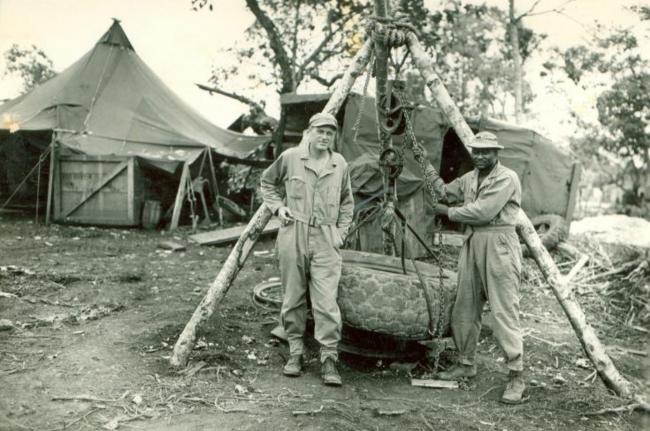





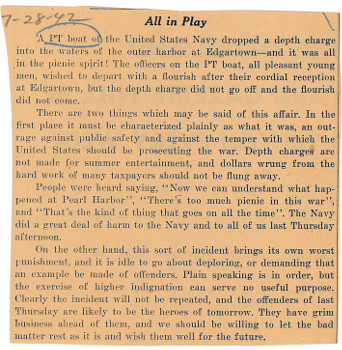
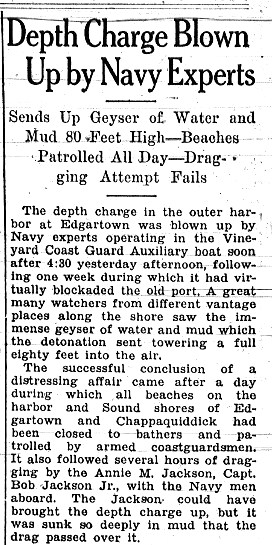
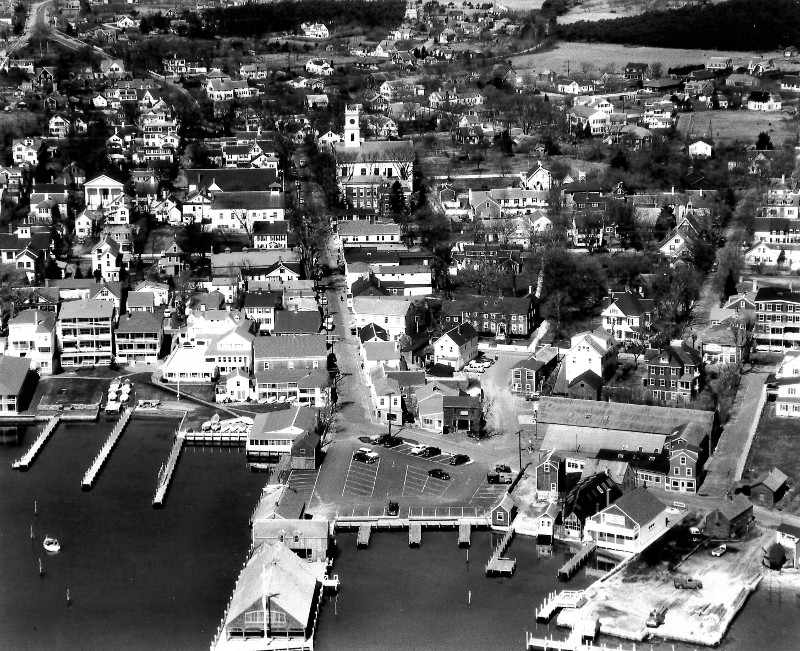
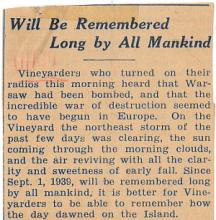
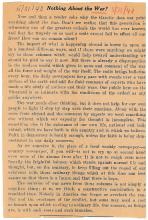

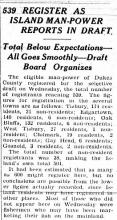

Comments